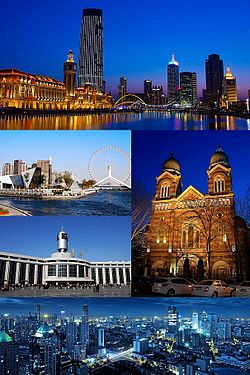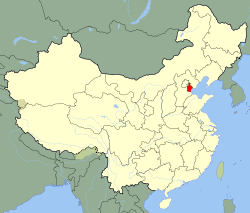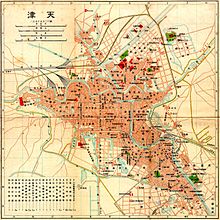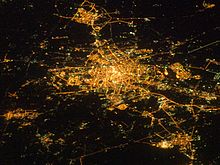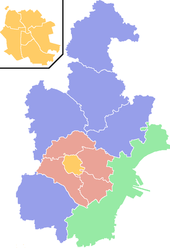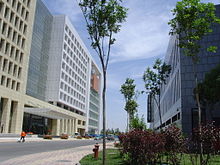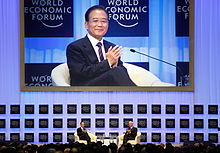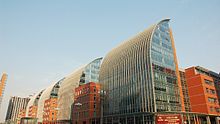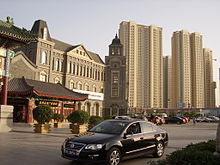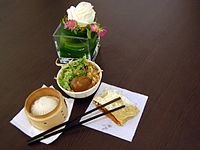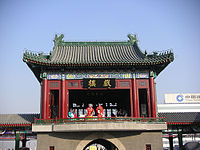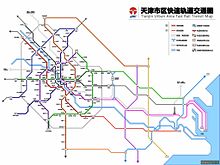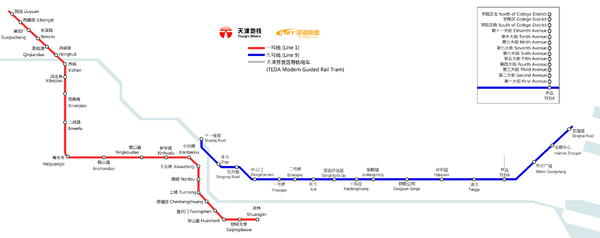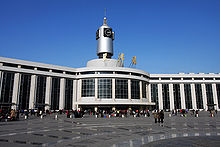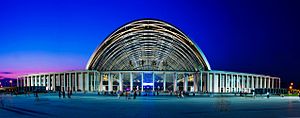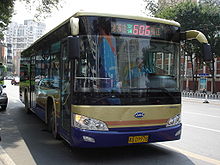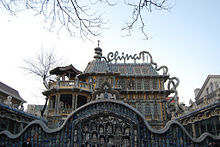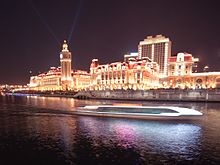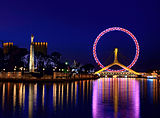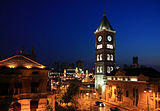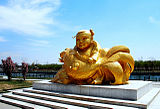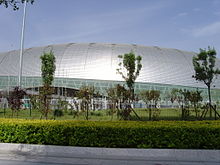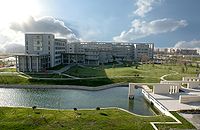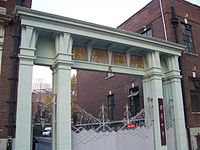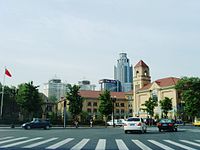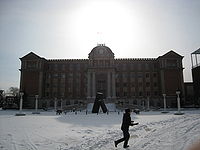- Tianjin
-
Tianjin
天津— Municipality — Municipality of Tianjin • 天津市 Location of Tianjin Municipality within China Coordinates: 39°08′N 117°11′E / 39.133°N 117.183°ECoordinates: 39°08′N 117°11′E / 39.133°N 117.183°E Country People's Republic of China Settled ca. 340 BC Divisions
- County-level
- Township-
level
13 districts, 3 counties
240 towns and villagesGovernment – Type Municipality – CPC Ctte Secretary Zhang Gaoli – Mayor Huang Xingguo Area – Municipality 11,760 km2 (4,540.6 sq mi) – Urban 174.9 km2 (67.5 sq mi) – Metro 5,606.9 km2 (2,164.8 sq mi) Population (2010 census) – Municipality 12,938,224 – Density 1,100.2/km2 (2,849.5/sq mi) – Urban 4,342,770 – Metro 10,290,987 Demonym Tianjinese
TianjinerTime zone China standard time (UTC+8) Postal code 300000 – 301900 Area code(s) 22 GDP 2010 - Total CNY 910.8 billion
(US$141.3 billion) (22nd)- Per capita CNY 62,403
(US$9681) (3rd)HDI (2008) 0.875 (3rd) – high Licence plate prefixes 津A, B, C, D, F, G, H, J, K, L, M
津E (taxis)City flower Chinese rose Website (Chinese) www.tj.gov.cn
(English) www.tj.gov.cn/englishTianjin Chinese 天津 Hanyu Pinyin Tiānjīn
 [Listen] (help·info)
[Listen] (help·info)Literal meaning sky ferry Transcriptions Hakka - Romanization Thiên-tsîn Mandarin - Hanyu Pinyin Tiānjīn
 [Listen] (help·info)
[Listen] (help·info)- Wade–Giles T'ien-chin - Postal Map Tientsin Min - Hokkien POJ Thian-tin Wu - Romanization thie平tsin平 Cantonese (Yue) - Jyutping tin1zeon1  Tianjin (help·info) (Chinese: 天津; pinyin: Tiānjīn; Mandarin pronunciation: [tʰjɛ́ntɕín]; Tianjinese: /tʰiɛn˨˩tɕin˨˩/~[tʰjɛ̃̀ɦɪ̀ŋ]; Postal map spelling: Tientsin) is a metropolis in northern China and one of the five national central cities of the People's Republic of China. It is governed as a direct-controlled municipality, one of four such designations, and is, thus, under direct administration of the central government. Tianjin borders Hebei Province and Beijing Municipality, bounded to the east by the Bohai Gulf portion of the Yellow Sea.
Tianjin (help·info) (Chinese: 天津; pinyin: Tiānjīn; Mandarin pronunciation: [tʰjɛ́ntɕín]; Tianjinese: /tʰiɛn˨˩tɕin˨˩/~[tʰjɛ̃̀ɦɪ̀ŋ]; Postal map spelling: Tientsin) is a metropolis in northern China and one of the five national central cities of the People's Republic of China. It is governed as a direct-controlled municipality, one of four such designations, and is, thus, under direct administration of the central government. Tianjin borders Hebei Province and Beijing Municipality, bounded to the east by the Bohai Gulf portion of the Yellow Sea.As a dual-core city, Tianjin is divided into the old city and the Binhai New Area. Binhai New Area is a new growth pole in China, and it maintains an annual growth rate of nearly 30% of the GDP. As of the end of 2010, 285 Fortune Global 500 companies have established branch offices in Binhai. It is a base of China's advanced industry, financial reform, and innovation.
In terms of urban population, it is the sixth-largest city of the People's Republic of China, and its urban land area (Binhai New Area is not included) ranks fifth in the nation after Beijing, Shanghai, Guangzhou, and Shenzhen. Tianjin's urban area is located along the Hai River, which connects to the Yellow and Yangtze Rivers via the Grand Canal in Tianjin. Tianjin was once home to foreign concessions in the late Qing Dynasty and early Kuomintang (KMT) era. The municipality incorporates the coastal region of Tanggu, home to the Binhai New Area and the Tianjin Economic-Technological Development Area (TEDA).
Contents
History
See also: Concessions in TianjinThe land where Tianjin lies today was created in historical times by sedimentation of various rivers entering the sea at Bohai Gulf, including the Yellow River, which entered the sea in this area at one point.
The opening of the Grand Canal of China during the Sui Dynasty prompted the development of Tianjin into a trading center. Until 1404, Tianjin was called "Zhigu" (直沽), or "Straight Port". In that year, the Yongle Emperor renamed the city Tianjin, means "the Heavenly Ford", to indicate that the Emperor (son of heaven) forded the river at that point. This is because he had indeed forded the river in Tianjin while on a campaign to scramble for the throne from his nephew. Later on, a fort was established in Tianjin, known as "Tianjin Wei" (天津卫), the Fort of Tianjin.
Tianjin was promoted to a prefecture in 1725. Tianjin County was established under the prefecture in 1731.
In 1856, Chinese soldiers boarded The Arrow, a Chinese-owned ship registered in Hong Kong flying the British flag and suspected of piracy, smuggling, and of being engaged in the opium trade. They captured 12 men and imprisoned them. In response, the British and French sent gunboats under the command of Admiral Sir Michael Seymour to capture the Taku forts (大沽砲台) near Tianjin in May 1858. At the end of the first part of the Second Opium War in June of the same year, the Treaties of Tianjin were signed, which opened Tianjin to foreign trade. The treaties were ratified by the Emperor of China in 1860, and Tianjin (known as Tientsin) was formally opened to Great Britain and France, so to the outside world. Between 1895 and 1900, Britain and France were joined by Japan, Germany and Russia, and even by countries without other Chinese concessions such as Austria-Hungary, Italy and Belgium, in establishing self-contained concessions in Tianjin, each with its own prisons, schools, barracks and hospitals. These nations left many architectural reminders of their rule, notably churches and thousands of villas. Today those villas provide an exotic flavour to Tianjin.
The presence of foreign influence in Tianjin was not always peaceful; one of the most serious violent incidents to take place was the Tianjin Church Incident (天津教案). In June 1870, the orphanage held by the Wanghailou Church (望海楼教堂), Our Lady of Victories, in Tianjin, built by French Roman Catholic missionaries, was accused of the kidnapping and brainwashing of Chinese children. On June 21, the magistrate of Tianjin County initiated a showdown at the church that developed into violent clashes between the church's Christian supporters and non-Christian Tianjin residents. The furious protestors eventually burned down Wanghailou Church and the nearby French consulate and killed eighteen foreigners including ten French nuns, the French consul, and merchants. France and six other Western nations complained to the Qing government, which was forced to pay compensation for the incident.
In June 1900, the Boxers were able to seize control of much of Tianjin. On June 26, belligerent European forces heading towards Beijing were stopped by Boxers at nearby Langfang, and were defeated and forced to turn back to Tianjin. The foreign concessions also came under siege for several weeks.
In July 1900, the Eight-Nation Alliance attacked and occupied Tianjin. They soon established the Tianjin Provisional Government, composed of representatives from each of the occupying forces (Russian, British, Japanese, German, French, American, Austro-Hungarian, and Italian). Tianjin was governed by this council until August 15, 1902 when the city was returned to Qing control. Eminent Qing General Yuan Shikai headed efforts to remake Tianjin into a modern city, establishing the first modern Chinese police force here. In 1907, Yuan supervised China's first modern democratic elections for a county council.
Tianjin was established as a municipality of China (直辖市) in 1927.
Western nations were permitted to garrison the area to ensure open access to Peking. The British maintained a brigade of two battalions there, and the Italians, French, Japanese, Germans, Russians, and Austro-Hungarians maintained understrength regiments; the United States did not initially participate. During World War I, the German and Austro-Hungarian garrisons were captured and held as Prisoners of War by Allied Forces while the Bolshevik government withdrew the Russian garrison in 1918. In 1920, the remaining participating nations asked the United States to join them, and the US then sent the 15th Infantry Regiment, less one battalion, to Tientsin from the Philippines.
Garrison duty was highly regarded by the troops. General George C Marshall, the "architect of victory" in World War II when he was the United States Army Chief of Staff, served at Tientsin in the 1920s as Executive Officer of the 15th Infantry. The US withdrew this unit in 1938 and a US presence was maintained only by the dispatch of a small US Marine Corps contingent from the Embassy Guard at Peking.
 The Binhai New Area
The Binhai New Area
On July 30, 1937, Tianjin fell to Japan, as part of the Second Sino-Japanese War, but was not entirely occupied, as the Japanese for the most part respected foreign concessions until 1941, when the American and British concessions were occupied. In the summer of 1939, there occurred a major crisis in Anglo-Japanese relations with the Tientsin Incident. On June 14, 1939, the Imperial Japanese Army surrounded and blockaded the British concession over the refusal of the British authorities to hand over to the Japanese six Chinese who had assassinated a locally prominent Japanese collaborator, and had taken refuge in the British concession. For a time, the 1939 crisis appeared likely to cause an Anglo-Japanese war, especially when reports of the maltreatment by the Japanese Army of British subjects wishing to leave or enter the concession appeared in the British press. The crisis ended when the British Prime Minister Neville Chamberlain was advised by the Royal Navy and the Foreign Office that the only way to force the Japanese to lift the blockade was to send the main British battle fleet to Far Eastern waters, and that given the current crisis in Europe that it would be inappropriate to send the British fleet out of European waters, thus leading the British to finally turn over the six Chinese, who were then executed by the Japanese. During the Japanese occupation, Tianjin was ruled by the North China Executive Committee, a puppet state based in Beijing.
On August 9, 1940, all of the British troops in Tianjin were ordered to withdraw. On November 14, 1941 the American Marine unit stationed in Tianjin was ordered to leave, but before this could be accomplished, the Japanese attacked the United States. The American Marine detachment surrendered to the Japanese on December 8, 1941. Only the Italian and French concessions (the local French officials were loyal to Vichy) were allowed to remain by the Japanese. Japanese occupation lasted until August 15, 1945, the surrender of Japan marking the end of World War II.
Tianjin holds the annual Meeting of the New Champions of World Economic Forum (also called Summer Davos) from 2008.
In October 2010, the UN Climate Change Conference convened in Tianjin.[1]
Geography
Tianjin Climate chart (explanation) J F M A M J J A S O N D 3.32−845−57.7121212193826157130201713123146302246261623209101114.14−5Average max. and min. temperatures in °C Precipitation totals in mm Imperial conversion J F M A M J J A S O N D 0.135190.241230.353340.869481.579582.886676.788735.786711.879620.967490.451340.23923Average max. and min. temperatures in °F Precipitation totals in inches Tianjin is located in Northern China along the coast of the Bohai Gulf, with latitude ranging from 38° 15' to 40° 14' N, and longitude ranging from 116° 43' to 118° 03' E. Surrounded by Hebei on all directions except for the sea and is bordered by Beijing to the northwest, it lies at the northern end of the Grand Canal of China, which connects with the Yellow River and Yangtze River. The municipality is generally flat, and swampy near the coast, but hilly in the far north, where the Yan Mountains intrude into northern Tianjin. The highest point in the municipality is Jiushanding Peak on the northern border with Hebei, at an altitude of 1078 m.
The Hai River forms within Tianjin Municipality at the confluence of the Ziya River(子牙河), Daqing River(大清河), Yongding River, North Grand Canal, and South Grand Canal, and enters the Pacific Ocean within the municipality as well, in Tanggu District. Major reservoirs include the Beidagang Reservoir in the extreme south (in Dagang District) and the Yuqiao Reservoir in the extreme north (in Ji County).
The urban area of Tianjin is found in the south-central part of the Municipality with 6 districts and 4,342,770 inhabitants. The built up area is much bigger and is home to 10,290,987 inhabitants on 12 districts including Binhai new district. This makes Tianjin agglomeration the fifth in China after Guangzhou – Dongguan – Shenzhen, Shanghai – Suzhou, Beijing and Shantou – Jieyang – Chaozhou conurbation.In addition to the main urban area, the coast along the Bohai is lined with a series of port towns, including Tanggu and Hangu.
Climate
Tianjin features a four season, monsoon-influenced climate, typical of East Asia, with cold, windy, very dry winters reflecting the influence of the vast Siberian anticyclone, and hot, humid summers, due to the monsoon. Spring in the city is dry and windy, occasionally seeing sandstorms blowing in from the Gobi Desert, capable of lasting for several days. Monthly mean temperatures range from −3.5 to 26.6 °C (25.7 to 79.9 °F) from January to July, with an annual average of 12.7 °C (54.9 °F). With precipitation being generous only during the summer months, and a low annual total of 540 millimetres (21.3 in), the city lies within the humid continental zone, with parts of the municipality being semi-arid (Köppen Dwa/BSk, respectively)[2]
Extreme temperatures have ranged from −22.9 to 40.5 °C (-9 to 105 °F).[3]
Climate data for Tianjin (1971–2000) Month Jan Feb Mar Apr May Jun Jul Aug Sep Oct Nov Dec Year Average high °C (°F) 1.8
(35.2)5.0
(41.0)11.7
(53.1)20.5
(68.9)26.1
(79.0)30.1
(86.2)31.0
(87.8)30.2
(86.4)26.3
(79.3)19.7
(67.5)10.6
(51.1)3.9
(39.0)18.1 Average low °C (°F) −7.5
(18.5)−4.9
(23.2)1.3
(34.3)8.9
(48.0)14.6
(58.3)19.7
(67.5)22.7
(72.9)21.9
(71.4)16.4
(61.5)9.3
(48.7)1.3
(34.3)−4.9
(23.2)8.2 Precipitation mm (inches) 3.3
(0.13)4.0
(0.157)7.7
(0.303)20.9
(0.823)37.7
(1.484)71.1
(2.799)170.6
(6.717)145.7
(5.736)46.1
(1.815)22.7
(0.894)10.4
(0.409)4.1
(0.161)544.3
(21.429)% humidity 56 54 53 51 56 64 76 77 68 64 63 59 61.8 Avg. precipitation days (≥ 0.1 mm) 1.8 2.1 2.9 4.4 6.0 8.0 12.4 10.2 6.0 4.5 3.5 2.0 63.8 Sunshine hours 178.3 176.9 205.3 229.8 265.7 251.2 217.6 223.3 223.3 211.1 173.1 166.2 2,521.8 Source: China Meteorological Administration[4] Administrative divisions
Main article: List of administrative divisions of TianjinTianjin is divided into 16 county-level divisions, including 13 districts and 3 counties.
- Urban districts
- Heping District
- Hedong District
- Hexi District
- Nankai District
- Hebei District
- Hongqiao District
- Binhai New Area
- Suburban districts
- Jinnan District
- Dongli District
- Xiqing District
- Beichen District
- Two rural districts and three rural counties
- Baodi District
- Wuqing District
- Ji County
- Jinghai County
- Ninghe County
In addition, the Tianjin Economic and Technological Development Area (TEDA) is not a formal level of administration, but nevertheless enjoys rights similar to a regular district.
Airport Industrial Park, Dongli District
These districts and counties are further subdivided, as of December 31, 2004, into 240 township-level divisions, including 120 towns, 18 townships, 2 ethnic townships and 100 subdistricts.
Politics
Main article: Politics of TianjinThe politics of Tianjin is structured in a dual party-government system like all other governing institutions in the mainland China.
The Mayor of Tianjin is the highest ranking official in the People's Government of Tianjin. Since Tianjin is a municipality, the Communist Party of China Municipal Committee Secretary is colloquially termed the "Tianjin CPC Party chief".
Economy
The nominal GDP for Tianjin was 750 billion yuan (US$110 billion) in 2009, a year-on-year increase of 16.5%.[5]
In 2009, per capita GDP was 62,403 yuan (US$9,136). The manufacturing sector was the largest (54.8%) and fastest-growing (18.2%) sector of Tianjin's economy. Urban disposable income per capita was 21,430 yuan, a real increase of 10.3% from the previous year. Rural pure income per capita was 10,675 yuan, a real increase of 10.4% from the previous year.
Farmland takes up about 40% of Tianjin Municipality's total area. Wheat, rice, and maize are the most important crops. Fishing is important along the coast. Tianjin is also an important industrial base. Major industries include petrochemical industries, textiles, car manufacturing, mechanical industries, and metalworking.
Tianjin Municipality also has deposits of about 1 billion tonnes of petroleum, with Dagang District containing important oilfields. Salt production is also important, with Changlu Yanqu being one of China's most important salt production areas. Geothermal energy is another resource of Tianjin. Deposits of manganese and boron under Tianjin were the first to be found in China.
EADS Airbus has already opened an assembly plant for its A320 series airliners, operational since 2009. AVIC I and AVIC II will be EADS' local partners for the site, to which subassemblies will be sent from plants around the world.[6]
Binhai New Area
- Tianjin Airport Industrial Park
- Tianjin Airport International Logistics Zone
Tianjin Airport International Logistics Zone is jointly invested by Tianjin Port Free Trade Zone and Tianjin Binhai International Airport. It is located inside the airfreight area of Tianjin Binhai International Airport. It has domestic and foreign excellent airfreight logistics enterprises engaged in sorting, warehousing, distribution, processing, exhibition. It is in the process of constructing the largest airfreight base in northern China.[7]
- Tianjin Baodi Economic and Technological Development Area
- Tianjin Economic & Technological Development Area (Also mentioned as TEDA)
- Tianjin Export Processing Zone
Located in the northeastern part of Tianjin Economy Development Area, Tianjin Export Processing Zone (TEPZ) has a planned area of 2.54 square kilometers, and the development area in Phase I is a square kilometer. The zone enjoys a convenient transport network, and it is located 40 km to Tianjin, 145 km to Beijing and 5 km to Tianjin Port.[8]
- Tianjin High-tech Industry Park
- Tianjin Port Free Trade Zone
Tianjin Port Free Trade Zone is the largest free trade zone in northern China as well as the only free trade zone in northern China and north-western China. The zone was approved to be established in 1991 by State Council. It is 30 km from Tianjin city proper, less than 1 km away from the wharf and only 38 km away from Tianjin Binhai International Airport.[9]
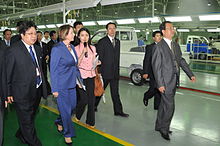 Nancy Pelosi – then Speaker of the United States House of Representatives, visits an electric car factory in Tianjin in 2009
Nancy Pelosi – then Speaker of the United States House of Representatives, visits an electric car factory in Tianjin in 2009
- Tianjin Tanggu National Marine High-Tech Development Area
Tianjin Tanggu Marine High-Tech Development Area was established in 1992, and was upgraded to the national-level high-tech development area by the State Council in 1995, it is the only national-level high-tech development area specializing in developing the marine Hi-Tech industry. By the end of 2008, the zone has 2068 corporations and has 5 industries there including new materials, oil manufacturing, modern machinery manufacturing, and electronic information.[10]
- Huayuan Area Industrial Development Park
- Wuqing Development Area
National Supercomputing Center
The current second fastest supercomputer in the world, Tianhe-1A, is located at the National Supercomputing Center in Tianjin.[11]
Demographics
Historical populations Year Pop. ±% 1953 2,693,831 — 1982 7,764,141 +188.2% 1990 8,785,402 +13.2% 2000 9,848,731 +12.1% 2010 12,938,224 +31.4% Population size may be affected by changes on administrative divisions. At the end of 2009, the population of Tianjin Municipality was 12.28 million, of which 9.8 million were residential holders of Tianjin hukou (permanent residence). Among Tianjin permanent residents, 5.99 million were urban, and 3.81 million were rural. The population will grow to 14 million. (out of which 11,5 million will be urban population)[12]
The majority of Tianjin residents are Han Chinese. There are also 51 out of the 55 minor Chinese ethnic groups living in Tianjin. Major minorities include Hui, Koreans, Manchus, and Mongols.
Ethnic groups in Tianjin, 2000 census Ethnicity Population Percentage Han 9,581,775 97.29% Hui 172,357 1.75% Manchu 56,548 0.57% Mongols 11,331 0.12% Korean 11,041 0.11% Zhuang 4,055 0.041% Tujia 3,677 0.037% Excludes members of the People's Liberation Army in active service.[13]
Media
Tianjin People's Broadcasting Station is the major radio station in Tianjin. Broadcasting in nine channels, it serves most of North China, part of East and Northeast China, reaching an audience of over 100 million.[14] (Chinese)Tianjin Television, the local television station, broadcasts in nine channels. It also boasts a paid digital channel, featuring home improvement programs.[15] (Chinese) Both the radio and television stations are now branches of the Tianjin Film, Radio and Television Group, established in October 2002.[16] (Chinese)
Major local newspapers include the Tianjin Daily and Jin Wan Bao (literally, tonight newspaper), which are the flagship papers of Tianjin Daily Newspaper Group and Jinwan Mass Media Group, respectively. There are also three English-language magazines: Jin, Tianjin Plus and Business Tianjin, mostly directed at ex-pats resident in the city.
Culture
People from urban Tianjin speak Tianjin dialect, which comes under the Mandarin subdivision of spoken Chinese. Despite its proximity to Beijing, Tianjin dialect sounds quite different from Beijing dialect, which provides the basis for Putonghua, the official spoken language of the People's Republic of China.
Tianjin cuisine places a heavy focus on seafood, due to Tianjin's proximity to the sea. Prominent menus include the Eight Great Bowls (八大碗), a combination of eight mainly meat dishes. It can be further classified into several varieties, including the rough (粗), smooth (S: 细 / T: 細), and high (高). The Four Great Stews (四大扒) actually refers to a very large number of stews, including chicken, duck, seafood, beef, and mutton.
Tianjin also has several famous snack items. Goubuli (狗不理包子) is a famous and traditional brand of baozi (steamed buns with filling) that is famous throughout China. Guifaxiang (桂发祥麻花) is a traditional brand of mahua (twisted dough sticks). Erduoyan (耳朵眼炸糕) is a traditional brand of fried rice cakes.
Tianjin is a respected home base of Beijing opera, one of the most prestigious forms of Chinese opera.
Western oil painting tells the fairy tale of China
Tianjin is famous for its stand up [comedy] and comedians including Guo Degang and Ma Sanli. Ma Sanli (马三立) (1914–2003), an ethnic Hui and longtime resident of Tianjin, is renowned for his xiangsheng (相声), a hugely popular form of Chinese entertainment similar to comedy. Ma Sanli delivered some of his xiangsheng in the Tianjin dialect. Tianjin, along with Beijing, is a center for the art of xiangsheng.[17]
Yangliuqing (Green Willows), a town about 15 km west of Tianjin's urban area and the seat of Tianjin's Xiqing District, is famous for its popular Chinese New Year-themed, traditional-style, colourful wash paintings (杨柳青年画). Tianjin is also famous for Zhang's clay figurines (泥人张) which are a type of colourful figurine depicting a variety of vivid characters, and Tianjin's Wei's kites (风筝魏), which can be folded to a fraction of their full sizes, are noted for portability.
Transport
Main article: Transport in TianjinThe Tianjin tram network was awarded to a Belgian company in 1904 and opened in 1906. It was the first city-wide tramway system in China. There were 402 bus lines in the city as of 2004.[18]
Construction work on the Tianjin Metro started on July 4, 1970. It was the second metro to be built in China and commenced service in 1984. The total length of track is 7.4 kilometers. The metro service was suspended on October 9, 2001 for reconstruction. This new metro is now called Line 1. It was re-opened to the public in June 2006. The track was extended to 26.188 kilometers and there will be a total of 22 stations. Previously, there were 8 stations. Several new metro lines are planned. Construction work on Line 2 and Line 3 are ongoing.
There is also a light railway line in the city, the Binhai Mass Transit line. The line runs between downtown Tianjin and TEDA (Tianjin Economic Development Area) in the seaside region. The eastern part of the line began service on March 28, 2004. The western part of the line is scheduled to be completed in 2006.
There is also a guided rail tram system in TEDA, called TEDA Modern Guided Rail Tram.
Rapid transit
Main articles: Tianjin Metro and Binhai Mass TransitThe municipality consists of two rapid transit systems, Tianjin Metro and Binhai Mass Transit. They are currently under heavy expansion from three to nine lines. Four lines are currently operating both in the City and the Binhai area.
As of October 2009, the entire network of Tianjin Metro and Binhai Mass Transit has 50 stations and 4 lines.
There are two rapid transit operators in Tianjin:
- Tianjin Metro. Presently operating 26 stations and two lines.
Number & Name Terminals Interchange Opening Year 1 Line 1 Shuanglin – Liuyuan – 1970 9 Line 9 Zhongshanmen – Xinlizhen B1 2004 - Binhai Mass Transit (BMT). Currently operates 24 stations in two lines.
Number & Name Terminals Interchange Opening Year B1 Line B1 Xinlizhen – Donghai Lu 9, T 2004 T TEDA MGRT TEDA – North of College District B1 2007 -
Modern Tram Translohr serving in Binhai New Area
Current map of Tianjin Metro and Binhai Mass Transit
Rail
There are several railway stations in the city, Tianjin Railway Station being the principal one. It was built in 1888. The station was initially located at Wangdaozhuang (S: 旺道庄 / T: 旺道莊). The station was later moved to Laolongtou (S: 老龙头 / T: 老龍頭) on the banks of the Hai He River in 1892, so the station was renamed Laolongtou Railway Station. The station was rebuilt from scratch in 1988. The rebuilding work began on April 15, 1987 and was finished on October 1, 1988. The Tianjin Railway Station is also locally called the 'East Station', due to its geographical position. In January 2007, the station began another long-term restructuring project to modernize the facility and as part of the larger Tianjin transport hub project involving Tianjin Metro lines 2, 3, and 9 as well as the Tianjin-Beijing High-speed rail.
Tianjin West Railway Station and Tianjin North Railway Station are also major railway stations in Tianjin. There is also Tanggu Railway Station is located in the important port area of Tanggu District, and TEDA Railway Station located in TEDA, to the north of Tanggu. There are several other railway stations in the city that do not handle passenger traffic.
Construction on a Beijing-Tianjin high-speed rail began on July 4, 2005 and was completed by August 2008.
The following rail lines go through Tianjin:
- Jingshan Railway, from Beijing to Shanhai Pass
- Jinpu Railway, from Tianjin to Pukou District, Nanjing
- Jinji Railway, from Tianjin urban area to Ji County, Tianjin
- Jinba Railway, from Tianjin to Bazhou, Hebei
Starting from Aug. 1, 2008, all trains stopping at the previous Tianjin Temporary Passenger Station will now instead use the newly completed Tianjin Railway Station.
Also, the inter-city trains between Beijing and Tianjin will adopt a new numbering system: Cxxxx (C stands for interCity.). The train numbers range between C2001~C2298:
- C2001~C2198: From Beijing South Station to Tianjin, non-stop.
- C2201~C2268: From Beijing South Station to Tianjin, with stops at Wuqing Station (武清站) or Yizhuang Station (亦庄站);
- C2271~C2298: From Beijing South Station to Tanggu Station of Tianjin.[19]
The new C trains take only 30 min between Beijing and Tianjin, cutting the previous D train time by more than a half. The ticket price as of Aug. 15, 08 is 69 RMB for the first-class seat and 58 RMB for the second-class seat.
Roads and expressways
Some spots in Tianjin, including roads and bridges, have names from Dr. Sun Yat-sen's Three Principles of the People (for example, Minquan Gate on Zhonghuan Road). Names harkening back to the era of the Republic of China on the mainland also appear (e.g. Beiyang Road). Many roads in Tianjin are named after a Chinese province or city. Also, Tianjin is unlike Beijing, in that very few roads run parallel to the major four compass directions.
Tianjin has three ring roads. Unlike Beijing, the Inner and Middle Ring Roads are not closed, traffic-controlled roadways and some often have traffic light intersections. The Outer Ring Road is the closest thing to a highway-level ring road, although traffic is often chaotic and sometimes more than chaotic.
Tianjin's roads often finish in dao (道 avenue), xian (S: 线 / T: 線) line, more used for highways and through routes) and lu (路 road). Jie (街 street) is rare. As Tianjin's roads are rarely in a cardinal compass direction, jing (S: 经 / T: 經) roads and wei (S: 纬 / T: 緯) roads often appear, which attempt to run more directly north-south and east-west, respectively.
The following seven expressways of China run in or through Tianjin:
- Jingjintang Expressway, from Beijing, through Tianjin's urban area, to Tanggu District / TEDA
- Jinghu Expressway, from Jinjing Gonglu Bridge to Shanghai (together with Jingjintang Expressway, this is the expressway from Beijing to Shanghai)
- Jingshen Expressway, through Baodi District on its way from Beijing to Shenyang
- Tangjin Expressway, from Tanggu District, Tianjin, to Tangshan, Hebei—known in Tianjin as the Jintang Expressway
- Baojin Expressway, from Beichen District, Tianjin, to Baoding, Hebei—known in Tianjin as the Jinbao Expressway
- Jinbin Expressway, from Zhangguizhuang Bridge to Hujiayuan Bridge, both within Tianjin
- Jinji Expressway, from central Tianjin to Jixian County
The following six China National Highways pass through Tianjin:
- China National Highway 102, through Ji County, Tianjin on its way from Beijing to Harbin
- China National Highway 103, from Beijing, through Tianjin's urban area, to Tanggu District
- China National Highway 104, from Beijing, through Tianjin Municipality, to Fuzhou
- China National Highway 105, from Beijing, through Tianjin Municipality, to Macau
- China National Highway 112, circular highway around Beijing, passes through Tianjin Municipality
- China National Highway 205, from Shanhaiguan, Hebei, through Tianjin Municipality, to Guangzhou
The expressways are sometimes closed due to dense fog particularly in the Autumn and Spring.
Airport
Tianjin Binhai International Airport (ZBTJ) is located in the east of the urban area, in Dongli District. The city will also be served by the new Beijing Daxing International Airport in Beijing, currently under construction and to be completed by 2017.[20]
Religion
Tianjin has a Buddhist Temple of Great Compassion, a Catholic St. Joseph’s Cathedral (Laoxikai Church), a Catholic Our Lady of Victory Church (Wanghailou Church) and a Tianjin Jewish Synagoge. A Roman Catholic Diocese of Tianjin exists. Official treatment of house churches is harsh.[21]
Tourism
Main attractions
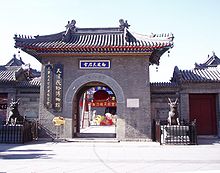 A Mazu Temple in Tianjin
A Mazu Temple in Tianjin
- Luzutang (Boxer Rebellion Museum)
- Guwenhua Jie, Ancient culture street
- Tianjin Wen Miao (文庙) (An important Temple of Confucius)
- Yuhuangge Taoist Temple (玉皇阁)
- Temple of Great Compassion Zen Buddhist Temple
- Tianhou Palace (天后宫), Temple dedicated to the goddess Mazu and biggest in the North China region
- Former Concessions in Tianjin
- Astor Hotel and its Museum 利顺德大酒店及利顺德博物馆
- Tianjin Radio and Television Tower
- Tianjin Eye, the world's only Ferris wheel built over a bridge and the world's 6th tallest overall
- Tianjin World Financial Center (336.9 metres (1,105 ft)) tall
- Tianjin Water Park, the largest urban park and recreation area in Tianjin
- Tianjin Zoo, home to approximately 3,000 animals of 200 species
- Tianjin Museum, the largest museum in Tianjin
- Hai River Park (海河公园)
- Tianjin Olympic Center Stadium, also known as "The Water Drop"
- Five Main Avenues (五大道)
- Italian Town (意式风情区)
- Shijia Dayuan 杨柳青:石家大院 Shi Family Residence
- Memorial to Zhou Enlai and Deng Yingchao
- The Century Clock of Tianjin 天津世纪钟 (Tianjin Shijizhong)
Sights outside the Tianjin urban area, but within the municipality, including the Tianjin Economic-Technological Development Area:
- Soviet aircraft carrier Kiev Theme Park (前苏联航空母舰主题公园)
- Polar marine animals theme park in Tianjin(天津极地海洋动物世界)
- TEDA Football Stadium, Home stadium of Chinese Super League team Tianjin Teda F.C.
- Taku Forts, Qing Dynasty cannon emplacement
- Huangya Pass, a section of the Great Wall of China
- Mount Panshan
- Sino-Singapore Tianjin Eco-city, a collaborative venture between the governments of China and Singapore
Sports teams
Sports teams based in Tianjin include:
- Tianjin Teda F.C. (天津泰达俱乐部)
Chinese Yi League
- Tianjin Songjiang (天津松江)
China Women Volleyball League
- Tianjin Bridgestone Women Volleyball Team
Education
See also: List of universities and colleges in TianjinColleges and universities
Tianjin University and Nankai University Joint Research BuildingUnder the National Ministry of Education:
- Nankai University (南开大学) (founded 1919,one of the most prestigious universities in China)
- Tianjin University (天津大学) (founded 1895, oldest university in China)
Under the national Civil Aviation Authority:
- Civil Aviation University of China (中国民航大学)
Under the government of Hebei Province:
- Hebei University of Technology (河北工业大学) (founded 1903, the earliest institute of technology in China)
Under the municipal government:
- Tianjin Academy of Fine Arts (天津美术学院)
- Tianjin Agricultural College (天津农学院)
- Tianjin Conservatory of Music (天津音乐学院)
- Tianjin Foreign Studies University (天津外国语大学)
- Tianjin Institute of Physical Education (天津体育学院)
- Tianjin Medical University (天津医科大学)
- Tianjin Normal University (天津师范大学)
- Tianjin Polytechnic University (天津理工大学)
- Tianjin University of Commerce (天津商业大学)
- Tianjin University of Finance & Economics (天津财经大学)
- Tianjin University of Science & Technology (天津科技大学)
- Tianjin University of Technology (天津工业大学)
- Tianjin University of Technology and Education (天津职业技术师范学院)
- Tianjin University of Traditional Chinese Medicine (天津中医药大学)
- Tianjin Urban Construction Institute (天津城市建设学院)
Foreign institutions:
- The Florida International University Tianjin Center, opened in 2006 as a cooperative venture between the municipal government and the Miami-based university.
- The Great Wall MBA Program Oklahoma City University Meinders School of Business, established in 1986 on the campus of Tianjin University of Finance & Economics.
Note: Institutions without full-time bachelor programs are not listed.
High schools
- Tianjin No. 1 High School (天津一中)
- Nankai High School (南开中学) founded 1904, and one of the most prestigious in China
- Yaohua High School (耀华中学) founded 1927
- Tianjin Shiyan High School (实验中学)
- Tianjin Xinhua High School (新华中学)
- Tianjin Foreign Languages School (TFLS) (天津外国语学院附属外国语学校)
- Tianjin No. 20 high School (天津市第二十中学)
- Tianjin Second Nankai High School (天津市第二南开中学)
- Tianjin No. 7 High School (天津七中)
- Tianjin No. 3 Middle School (天津市第三中学)
- Tianjin No. 5 High School (天津五中)
- Tianjin No. 4 High School (天津四中)
- No 42 High School (42中学)
- No 41 High School (41中学)
- Haihe High School (海河中学)
- Tianjin High School(天津中学)
International relations
See also: List of twin towns and sister cities in ChinaTwin towns – Sister cities
Tianjin is twinned with:
City Country Sister city since:  Kobe
KobeJapan June 24, 1973  Fitchburg, Massachusetts
Fitchburg, MassachusettsUnited States  Philadelphia
PhiladelphiaUnited States February 10, 1980  Dallas
DallasUnited States  Mobile
MobileUnited States  Greenville, South Carolina
Greenville, South CarolinaUnited States  Rishon LeZion
Rishon LeZionIsrael  Melbourne
MelbourneAustralia May 5, 1980  Yokkaichi, Mie
Yokkaichi, MieJapan October 28, 1980  Sarajevo
SarajevoBosnia and Herzegovina May 28, 1981  Nord-Pas-de-Calais
Nord-Pas-de-CalaisFrance October 10, 1984  Milan
MilanItaly May 9, 1985  Groningen
GroningenNetherlands September 12, 1985  Chiba
ChibaJapan May 7, 1986  Kutaisi
KutaisiGeorgia  Plovdiv Region
Plovdiv RegionBulgaria October 15, 1989  İzmir
İzmirTurkey September 23, 1991  Abidjan
AbidjanCôte d'Ivoire September 26, 1992  Ulan Bator
Ulan BatorMongolia September 27, 1992  Kharkiv
KharkivUkraine June 14, 1993  Jönköping
JönköpingSweden September 23, 1993  Incheon
IncheonSouth Korea December 7, 1993  Łódź
ŁódźPoland October 1, 1994  Rio de Janeiro (state)
Rio de Janeiro (state)Brazil April 18, 1995  Amazonas State
Amazonas StateBrazil October 20, 1997  Haiphong
HaiphongVietnam January 8, 1999  Turku
TurkuFinland August 17, 2000  Clarence, New York
Clarence, New YorkUnited States November 10, 2001  Thessaloniki
ThessalonikiGreece March 4, 2002  Nampo
NampoNorth Korea August 11, 2002  Phnom Penh
Phnom PenhCambodia November 17, 2008 Astronomical phenomena
At 39°07.5′N 117°11.7′E / 39.125°N 117.195°E, the previous total solar eclipse was the solar eclipse of October 28, 1277, the next total solar eclipse will be on July 6, 2187.
Total solar eclipses from 1001 to 3000 are:
- 1277-Oct-28 13:21 CST
- 2187-Jul-06 17:13 CST
- 2415-Apr-10 10:49 CST
- 2636-May-27 05:09 CST
- 2762-Aug-12 09:43 CST
Annular solar eclipses from 1001 to 3000 are:
- 1189-Feb-17 11:37 CST
- 1292-Jan-21 13:30 CST
- 1665-Jan-16 16:42 CST
- 1802-Aug-28 15:48 CST
- 2118-Mar-22 15:33 CST
- 2439-Jun-12 07:52 CST
- 2686-Sep-10 07:12 CST
- 2739-Apr-30 08:41 CST
- 2894-Dec-18 14:38 CST
Wikisource has an article about solar eclipses as seen from Tianjin from 2001 to 3000.
See also
- 天津 ("Heaven's port") is also the name of an asterism in the Chinese constellation of Girl Mansion (女宿)
- Gao Lingwen, founder of Tianjin's first public school
- List of cities in the People's Republic of China by population
- American, Austro-Hungarian, British, French, Italian, Belgian, Russian and Japanese Concessions in Tianjin
References
- ^ By the CNN Wire Staff. "Global climate talks kick off in China". CNN. http://www.cnn.com/2010/WORLD/asiapcf/10/04/china.climate.talks/index.html?hpt=T2. Retrieved 2011-03-15.
- ^ Peel, M. C. and Finlayson, B. L. and McMahon, T. A. (2007). "Updated world map of the Köppen-Geiger climate classification". Hydrol. Earth Syst. Sci. 11: 1633–1644.
- ^ "Extreme Temperatures Around the World". http://www.mherrera.org/temp.htm. Retrieved 2010-08-28.
- ^ "中国地面国际交换站气候标准值月值数据集(1971-2000年)" (in Simplified Chinese). China Meteorological Administration. June 2011. http://cdc.cma.gov.cn/shuju/index3.jsp?tpcat=SURF&dsid=SURF_CLI_CHN_MUL_MMON_19712000_CES&pageid=3. Retrieved 2010-11-20.
- ^ "Tianjin's GDP hits 16.5 percent". China Daily. http://www.chinadaily.com.cn/regional/2010-01/27/content_9387130.htm. Retrieved 2011-03-15.
- ^ "Airbus signs framework agreement with Chinese consortium on A320 Final Assembly Line in China." EADS Airbus official press release. October 26, 2006.
- ^ "Tianjin Airport International Logistics Zone". RightSite.asia. http://rightsite.asia/en/industrial-zone/tianjin-airport-international-logistics-zone/. Retrieved 2011-03-15.
- ^ "Tianjin Export Processing Zone". RightSite.asia. http://rightsite.asia/en/industrial-zone/tianjin-export-processing-zone/. Retrieved 2011-03-15.
- ^ Rightsite.asia
- ^ Rightsite.asia
- ^ [1]
- ^ "第二次湖南R&D资源清查主要数据公报(第四号)". Stats.gov.cn. 2011-02-21. http://www.stats.gov.cn/was40/gjtjj_detail.jsp?channelid=4362&record=6. Retrieved 2011-03-15.
- ^ Source: Department of Population, Social, Science and Technology Statistics of the National Bureau of Statistics of China (國家統計局人口和社會科技統計司) and Department of Economic Development of the State Ethnic Affairs Commission of China (國家民族事務委員會經濟發展司), eds. Tabulation on Nationalities of 2000 Population Census of China (《2000年人口普查中國民族人口資料》). 2 vols. Beijing: Nationalities Publishing House (民族出版社), 2003. (ISBN )
- ^ "天津人民广播电台". Radiotj.com. 2010-12-22. http://www.radiotj.com/dtjj/index.htm. Retrieved 2011-03-15.
- ^ [2][dead link]
- ^ [3][dead link]
- ^ McDougall, Bonnie S. (1984). Popular Chinese literature and performing arts in the People's Republic of China, 1949–1979. University of California Press. pp. 84.
- ^ Tianjin Bus Company official website. (Chinese)
- ^ "New Beijing-Tianjin intercity train numbering system". Shike.org.cn. 2008-07-31. http://www.shike.org.cn/news.asp?nId=3175. Retrieved 2011-03-15.
- ^ http://www.telegraph.co.uk/news/worldnews/asia/china/8752665/China-to-build-worlds-biggest-airport.html
- ^ http://www.unhcr.org/refworld/pdfid/4b6fe1800.pdf
Further reading
- O. D. Rasmussen (1925). Tientsin: An Illustrated Outline History. Tientsin: Tientsin Press. OCLC 2594229. http://books.google.com/books?id=E7w5AAAAMAAJ.
External links
- Tianjin Government website
- Tianjin Expats
- Economic profile for Tianjin at HKTDC
- Tianjin Guide
- Official Tianjing Media Gateway
- Tianjin Taoist Association
- Historic US Army map of Tianjin, 1945
- Official promotional vedio of Tianjin City
- Tianjin travel guide from Wikitravel
 Chisholm, Hugh, ed (1911). "Tientsin". Encyclopædia Britannica (11th ed.). Cambridge University Press.
Chisholm, Hugh, ed (1911). "Tientsin". Encyclopædia Britannica (11th ed.). Cambridge University Press.
 Geographic locale
Geographic locale
Lat. and Long. 39°08′N 117°11′E / 39.133°N 117.183°E
Langfang (Hebei) and Beijing Chengde (Hebei) Tangshan (Hebei) 
Langfang (Hebei) 
Bohai Gulf  Tianjin
Tianjin 

Cangzhou (Hebei) Cangzhou (Hebei) Bohai Gulf Articles Related to Tianjin Municipality of Tianjin Districts Counties Roads and Expressways of Tianjin Ring Roads Expressways Jingjintang Expressway · Jinghu Expressway · Jingshen Expressway · Tangjin Expressway · Baojin Expressway · Jinbin Expressway · Jinji ExpresswayChina National Highways Landmarks in Tianjin Buildings and structures Luzutang • Shuishang Gongyuan • Tianjin Radio and Television Tower • Haihe Park • Wuda Dao • Shijia Dayuan • Tianhougong • Fort Dagukou • Huangyaguan Great WallNature and parks Mount Pan • Tianjin Water Park • Tianjin ZooCultural institutions Guwenhua Jie • Tianjin Museum • Italian District • Temple of Great Compassion • Wanghailou Church • Xikai Church • Zhou Enlai Memorial Hall • Guwan Shichang • Wen Miao • Porcelain House • St. Joseph CathedralSports venues Transport Tianjin Binhai International Airport • Tianjin Metro • Binhai Mass Transit • Tianjin Railway Station • Beijing–Tianjin Intercity RailwayBohai Economic Rim Region List of major cities and ports in the BER regionMunicipalities Hebei Province Liaoning Province Shandong Province Provincial level divisions of the People's Republic of China Provinces 
Autonomous regions Municipalities Special Administrative Regions Territorial disputes - Paracel, Spratly, Zhongsha Islands (see Paracels, Spratlys, & Zhongsha Iss. Authority)
- Pratas Islands
- Senkaku Islands
- South Tibet
- Taiwan, Kinmen & Matsu (see Legal status of Taiwan)
Metropolitan cities of the People's Republic of China Municipalities and National central cities Regional central cities Special administrative regions Sub-provincial cities (not included above) Separate state-planning cities (not included above) Provincial capitals (not included above) Autonomous regional capitals Comparatively large cities (not included above) Special economic zone cities (not included above) Coastal development cities (not included above) XPCC / Bingtuan cities State-level new areas Pudong New Area (Shanghai) · Binhai New Area (Tianjin) · Liangjiang New Area (Chongqing) · Zhoushan Archipelago New Area (Zhoushan)Most populous metropolises in the People's Republic of China World's fifty most-populous urban areas Categories:- Tianjin
- Independent cities
- Municipalities of the People's Republic of China
- North China Plain
Wikimedia Foundation. 2010.

